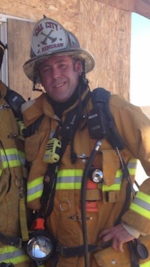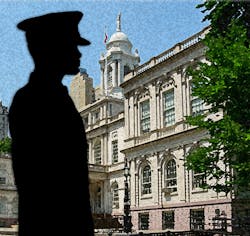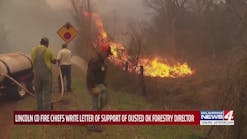The headline in the local newspaper, the lead story on the nightly news and multiple social media posts all are about the candidate who recently was appointed to the fire chief’s position.
Numerous family members, friends and colleagues send their well wishes and congratulate the new chief, and in doing so they echo some of each other’s statements: “You are so deserving,” “You worked so hard for this” and “They are lucky to have you.”
New chiefs, whether it be early in their career or even much later, set this goal for themselves, to someday wear five bugles on their uniform collar. There was a lot of preparation along the way, particularly educational opportunities, being mentored and observing those who were above them in the chain of command. They strove to be well-versed in departmental operations, the day-to-day administrative functions, budgeting and capital projects.
Nevertheless, on that first day on the job, a new chief’s scope expands—to city hall. Above the fire chief in the government hierarchy is the city/municipal manager, and above that person are all of the elected officials. Depending on the makeup of the municipality, those people can include council members, supervisors, commissioners, etc.
To be effective leaders and to make their department relevant within the municipal government, new fire chiefs must be able to develop relationships, to collaborate, and to create an environment of mutual respect and understanding. Furthermore, just like for any emergency scene, fire chiefs can do whatever they can to prepare, but they must be ready to change their strategies and go to Plan B, C or D when the current tactics that they are applying aren’t effective when working with elected municipal officials. Local governments can experience drastic changes with or without notice. These changes can take place during the primary and general elections, when, of course, significant turnover of elected officials can occur, as well as when an event, such as a pandemic, affects every level of the government in a multitude of ways.
Fire chiefs shouldn’t look at city hall as if it’s the “lion’s den,” dreading every time that they must cross its threshold. They should consider it a place where everyone works in the best interest of the citizens and where department heads are given the support that they need, so they and their agency can be successful and provide top-notch service to the community.
Preplanning
Shortly after their employment contract is signed, new fire chiefs will get to work on a number of projects and tasks. On the to-do list should be time that’s dedicated to researching as much as possible about their new bosses. Similar to an engine company conducting a preplan of a commercial building, fire chiefs can do the same to help themselves “size up” the elected officials with whom they will work and engage.
A quick internet search can produce news articles, interviews and social media pages that provide a lot of information. This information can be anything from the elected officials’ platform as candidates to speeches that they gave regarding their stance on municipal issues and on the services that are provided.
Speaking with the city/municipal manager is another great way to gauge where the fire department stands, how it’s viewed and whether there are any current problems or issues. The manager can provide to the new chief any expectations that municipal officials have for the municipality’s department heads as well as any procedures that must be followed.
Meeting with other department heads likely provides a lot of the same information that was gathered after the new chief met with the manager but from a different perspective, which can prove to be invaluable. The department heads were in the same position in their career that the new fire chief is in now.
A review of meeting agendas and minutes can provide insight into how meetings are conducted, historical information regarding how elected officials voted and what officials’ constituents said in regard to the services that they were provided.
Taking the time to learn as much as possible about how elected officials work individually and as a group provides new fire chiefs with a better understanding of how to adapt their role to work with the municipality’s elected officials effectively.
First impression
There is an old saying, “You never get a second chance to make a first impression.” This applies to new fire chiefs when they first are exposed to their new municipal bosses. Typically, this happens at a meeting, with an introduction to the public, followed by the official swearing in and badge-pinning. Usually, new fire chiefs get the chance to address everyone who is present and, maybe, elaborate on any plans or initiatives that they want to implement. This is their time to shine and to make a good first impression.
However, the first impression can and should start even before the meeting begins. New chiefs should arrive early and seek out the elected officials and introduce themselves. It shows the excitement that new chiefs have for their new position and it starts relationship-building. More importantly, it lays the groundwork for the development of mutual respect.
That said, making a good impression should continue through the duration of fire chiefs’ career. When attending monthly or bimonthly meetings, make the effort to arrive early and seek out the elected officials. Make the time to talk to them one-on-one and to discuss any recent events that happened in the department, particularly if the event happened in a district or ward that the individual represents. It might not happen right away, but over time, the dialogue will increase the more that you make the effort to be personable.
Showtime
The time when fire chiefs and their department regularly are on display is at the municipal meeting. These meetings are attended by the elected officials, the city/municipal manager, department heads and members of the public. With the increase of audio/video technology, meetings can be broadcast over numerous mediums, which, of course, increases the amount of people who have the ability to watch the meeting.
A typical meeting agenda covers old or continuing business, new business, consent calendar items, check registers and department head reports. Fire chiefs must be ready to discuss any questions that are directed toward them by the municipal officials or the public. These questions can cover business items or might be more focused, such as someone who wants to know the purpose of a single financial transaction. If fire chiefs don’t have an answer, it’s best to not give falsities or provide improper information. It’s better to say that they must look into the matter to provide an answer in the near future.
Some municipal officials might ask questions or want items clarified days before the meeting. This gives fire chiefs the time to do the research and to provide a longer, more thorough answer than what might be possible at a public meeting, particularly because of the time constraints that might be present that day/evening.
Those same time constraints can hinder fire chiefs’ ability to showcase recent department happenings. Because of this, a brief but thorough activity report should be submitted, which can be included in the agenda packet and viewed by all who are in attendance. This type of report gives the basic statistical data, such as the number and types of calls, property loss versus property saved, aid given and received, etc. Any pertinent department news, other than numerical data, also should be included. This provides the chance to showcase major staff accomplishments, public relations events either attended or hosted, and future department activities. Even if fire chiefs are unable to attend the meeting, they still are able to relay relevant information to those who do attend.
It’s important to remember that the activity report should be tailored to what particular municipal officials prefer. This can be learned early on, by reviewing previous meeting agendas and minutes and seeing what your predecessor submitted and to what the elected officials were receptive. The activity report might need to change as the political climate and times change, because the expectations of the fire chief and of the fire department might alter. In any case, it’s crucial that the appropriate, applicable information is communicated in the report.
As discussed above, fire chiefs shouldn’t be threatened nor feel timid when they must be within the boundaries of city hall. In addition to being there for the regularly scheduled meetings, chiefs should make it a point to show their face there on a regular basis. I’m not saying to loiter and disrupt other employees but be present for the staff to learn who you are and for the elected officials, who likely are there on a regular basis, to see you engaging and immersing yourself as part of the bigger picture of the municipal government.
Be available, be present
Elected officials will be asked questions regularly by their constituents. They can cover a range of topics, but, more often than not, some will be about the fire department. If the officials don’t know the answer, they will contact the person who should know the answer: the fire chief. If it involves a major incident that occurred or something that garnered a lot of media coverage or generated buzz, fire chiefs should be proactive and make the notifications before questions are asked. This ensures that the fire department is in control of the message but also that elected officials are included in the briefing portion of the event. With this gesture, fire chiefs show their ability to communicate. By making this notification, they afford the respect that they expect in return from the elected officials.
That said, there are times that this won’t work. This is where fire chiefs must learn what the expectations are and have multiple ways that they can be available to the elected officials—either by phone, email or text. Facilitating a method to be contacted 24/7/365 not only is part of the job but also is a big step toward developing a mutually respectful working relationship.
Both sides must remember that calling/emailing/texting is for business only and shouldn’t be taken advantage of for personal or professional gain. There likely will be past practice or policy that can provide guidance to ensure that all parties operate ethically.
Stay engaged
Unfortunately, there is no guide or book that has all of the answers for fire chiefs who want to improve their relationship with elected officials. There are so many differing attitudes, visions and objectives that fire chiefs will encounter. Couple this with the always-present hidden agendas, egos, uneducated judgements and strained connections from the past and it’s almost impossible for a one-size-fits-all approach. It’s the responsibility of fire chiefs to put forth the effort to figure out what works and what doesn’t. Opening up the lines of communication early shows the eagerness to want to get off on the right foot and the desire to establish a valuable working relationship.
Fire chiefs always should be thinking of ways to stay engaged, which helps to favorably sway opinion of them. This transfers to the department, which ensures that both the chief and the department can be successful going forward.
Jared Renshaw will present “A New Chief’s Guide to Surviving Local Politics” at Firehouse Expo. To register, visit firehouseexpo.com.

Jared Renshaw
Jared Renshaw has more than 20 years of experience in the fire service. He started his fire service career with the Fairview Volunteer Fire Department in South Fayette Township, PA. Renshaw also served with career departments in South Carolina and California and since 2015 has served as the fire commissioner with the Western Berks Fire Department in Berks County, PA. He holds a bachelor's degree in fire service administration and is designated as a Chief Fire Officer through the Center for Public Safety Excellence (CPSE). Renshaw serves as a Peer Reviewer for the CPSE and as a member of the board of directors for the Pennsylvania Fire and Emergency Services Institute. He is a member of the advisory boards for Firehouse and Firehouse Expo.






